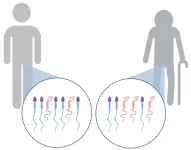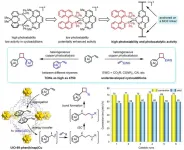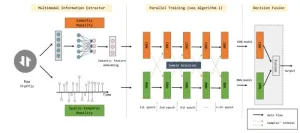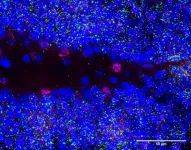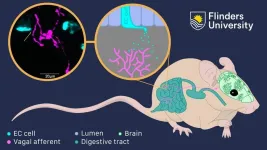(Press-News.org) ROCKVILLE, Md.— High-fat diets cause obesity in male mice. The underlying mechanism, however, remains controversial. After assessing three contrasting ideas, researchers have determined that the hedonic overdrive model provides the best fit, according to a new study published in the journal Obesity, The Obesity Society’s (TOS) flagship journal.
“Our work provides some direction as to why high-fat/high-carb macronutrient combinations stimulate overconsumption. The study is in mice so we need to be cautious about extrapolating to humans. However, if the effect is repeated in humans, avoiding the macronutrient combos that stimulate us to overeat would seem a good strategy to prevent obesity,” said John R. Speakman, director of the Shenzhen Key Laboratory of Metabolic Health, Center for Energy Metabolism and Reproduction, Shenzhen Institute of Advanced Technology, Chinese Academy of Sciences, Shenzhen, China. Speakman is the corresponding author of the study.
Experts explain that when fed a diet containing more than 40% fat by calories, the males of many strains of mice deposit large amounts of body fat. However, the effects in females are smaller. The underlying mechanism generating the obesity effect in males is not well understood because studies have not performed measurements frequently enough or used a sufficient range of different diets to test among alternative ideas.
In the current study, researchers assessed the responses of 240 individually-housed 12-week-old C57BL/6 male mice against 3 patterns predicted by hedonic overdrive, reverse causality and passive overconsumption models. A baseline period of 7 days took place feeding all the mice a standard low-fat diet that contained 10% fat, 20% protein and 70% carbohydrate by energy. The mice were then exposed to 12 different diets that varied in their fat, protein and carbohydrate contents for 30 days. All the diets analyzed had more than 40% fat by calories.
Body weight and food intake were measured daily over the baseline period and after switching to the experimental diets for 30 days. Food intake was measured from the weight of food that went missing from the food hopper each day. Mice occasionally pulled pellets of food through the hopper bars or ground their food; therefore, a thorough search of the cage was made to return any uneaten food to the hopper before weighing.
Results showed the hedonic overdrive model provided the best fit for the data analysis. The reverse causality and passive overconsumption models were not well supported. After exposure to the diets, energy intake increased first and body weight followed later. Intake then declined. The peak energy intake was dependent on both dietary protein and carbohydrate, but not the dietary fat and energy density, whereas the rate of decrease in intake was only related to dietary protein.
On the high-fat diets, the weight of food intake declined, but despite this average reduction of 14.4 g in food intake, the mice consumed on average 357 kJ more energy than at baseline. The fact they gained weight in this situation is a direct refutation of the mass balance model of obesity.
“Using multiple defined diets varying in macronutrient composition followed by statistical modeling of food intake patterns in male mice over a 30-day period, this study reinforces the idea that diet palatability, and not energy content, drive overconsumption beyond actual caloric needs. As the authors acknowledge, the study also reveals that the analysis of food intake patterns requires even more sophisticated statistical modeling methods to better understand the role of each macronutrient in both the initiation and cessation of eating,” said Professor Catherine M. Kotz, PhD, of the University of Minnesota. Kotz was not associated with the research.
The study’s authors noted that it remains a mystery as to why female C57BL/6 mice do not have the same magnitude of response to overconsumption when exposed to high-fat diets, and added that this would be a profitable area for further research.
Other authors of the study include Lin Gao, Sumei Hu, Min Li, Xueying Zhang and Chaoqun Niu, Shenzhen Key Laboratory of Metabolic Health, Center for Energy Metabolism and Reproduction, Shenzhen Institute of Advanced Technology, Chinese Academy of Sciences, Shenzhen, China; Dengbao Yang, Lu Wang, Jacques Togo, Yingga Wu, Baoguo Li, Guanlin Wang, Li Li, Yanchao Xu, Moshen Mazidi, State Key Laboratory of Molecular Developmental Biology, Institute of Genetics and Developmental Biology, Chinese Academy of Sciences, Beijing, China. Gao, Hu, Li, Zhang and Niu are also associated with this laboratory and institute. Gao also works at the University of Chinese Academy of Sciences, Beijing, China. Authors also include Elspeth Couper and Andrew Whittington-Davies, Institute of Biological and Environmental Sciences, University of Aberdeen, United Kingdom.
The authors declared no conflicts of interest.
The study, titled “The Hedonic Overdrive Model Best Explains High-Fat Diet-Induced Obesity in C57BL/6 Mice” will be published in the April 2024 issue of Obesity.
# # #
The Obesity Society (TOS) is the leading organization of scientists and health professionals devoted to understanding and reversing the epidemic of obesity and its adverse health, economic and societal effects. Combining the perspective of researchers, clinicians, policymakers and patients, TOS promotes innovative research, education and evidence-based clinical care to improve the health and well-being of all people with obesity. For more information, visit www.obesity.org.
END
The tone and tuning of musical instruments has the power to manipulate our appreciation of harmony, new research shows. The findings challenge centuries of Western music theory and encourage greater experimentation with instruments from different cultures.
According to the Ancient Greek philosopher Pythagoras, ‘consonance’ – a pleasant-sounding combination of notes – is produced by special relationships between simple numbers such as 3 and 4. More recently, scholars have tried to find psychological explanations, but these ‘integer ratios’ are still credited with making a chord sound beautiful, and deviation from them ...
A new paper in Genome Biology and Evolution, published by Oxford University Press, finds that the link between paternal age and rare congenital disorders is more complex than scientists had previously thought. While researchers have long realized that older fathers are more likely to have children with bone and heart malformations, such as Achondroplasia, Apert, or Noonan syndrome or neurodevelopmental disorders, schizophrenia, and autism, new examination indicates that while the link between some pathogenic mutations increases with paternal age, others do not and may even occur in the father’s testis before sexual maturity.
Delayed fatherhood results in a higher ...
A study into parental smoking and childhood obesity has challenged previous notions by revealing that the links between the two are not confined to a specific socio-economic group.
The data shows a strong correlation between parents who smoke and their children’s consumption of high calorie unhealthy foods and drinks, across social classes.
Using longitudinal data on 5,000 Australian children collected over a 10-year period, the research found those living with parents who smoke, on average, eat less healthy, higher calorie food such as fruit juice, sausages, fries, snacks, full fat milk products, ...
Professor Jian HE, from the Department of Chemistry at The University of Hong Kong (HKU), has spearheaded a research endeavour aimed at revolutionising organic synthesis. His research team has successfully developed a novel heterogeneous copper photocatalyst that enables the efficient formation of cyclobutane rings, a crucial structural element in a vast array of bioactive molecules. Cyclobutane rings are prominently featured in pharmaceuticals, natural products, and various biologically active compounds. By enabling researchers to construct these rings easily and selectively, ...
The success of a deep learning-based network intrusion detection systems (NIDS) relies on large-scale, labeled, realistic traffic. However, automated labeling of realistic traffic, such as by sand-box and rule-based approaches, is prone to errors, which in turn affects deep learning-based NIDS.
To solve the problems, a research team led by Yuefei ZHU published their new research on 15 Feb 2024 in Frontiers of Computer Science co-published by Higher Education Press and Springer Nature.
The team ...
Researchers at the Centre for Genomic Regulation (CRG) reveal that the Snhg11 gene is critical for the function and formation of neurons in the hippocampus. Experiments with mice and human tissues revealed the gene is less active in brains with Down syndrome, potentially contributing to the memory deficits observed in people living with the condition. The findings are published today in the journal Molecular Psychiatry.
Traditionally, much of the focus in genomics has been on protein-coding genes, which in humans constitutes around just 2% of the entire genome. The rest is "dark ...
In The BMJ today, Keisha Bentley-Edwards at Duke University, North Carolina, and colleagues argue that systemic racism and economic inequality are at the root of disparity in covid-19 outcomes and suggest how to distribute resources more equitably.
The article is part of a series that highlights the lessons that can be learned from the US’s covid-19 experience and the actions that are needed to prevent the loss of another million citizens in the next pandemic and improve and protect population health.
"Rather than waiting for the next pandemic to address systemic failures, the ...
A group led by researchers at Nagoya University and Meijo University in Japan has developed a disinfection technology that uses low-temperature plasma generated by electricity to cultivate environmentally friendly hydroponically grown crops. This innovative technology sterilizes the crops, promoting plant growth without the use of chemical fertilizers. Their findings appeared in Environmental Technology & Innovations.
In hydroponic agriculture, farmers cultivate plants by providing their roots with a nutrient solution. However, the nutrient solution can become infected with pathogenic E. coli strains, contaminating the crop and leading to foodborne illnesses.
To avoid ...
Two major studies part-funded by Cancer Research UK reveal that the use of chemotherapy and radiotherapy in the UK has lagged behind comparable countries in the past decade
Patients faced longer waits to begin key cancer treatment, which could be impacting people’s chances of survival in the UK
With an upcoming UK general election, Cancer Research UK is calling on political leaders to step up and ensure patients get the level of care that they deserve
People in the UK were treated with chemotherapy ...
The mechanisms by which antidepressants and other emotion-focused medications work could be reconsidered due to an important new breakthrough in the understanding of how the gut communicates with the brain.
New research led by Flinders University has uncovered major developments in understanding how the gut communicates with the brain, which could have a profound impact on the make-up and use of medications such as antidepressants.
“The gut-brain axis consists of complex bidirectional neural communication pathway between the brain and the gut, which links emotional and cognitive ...
